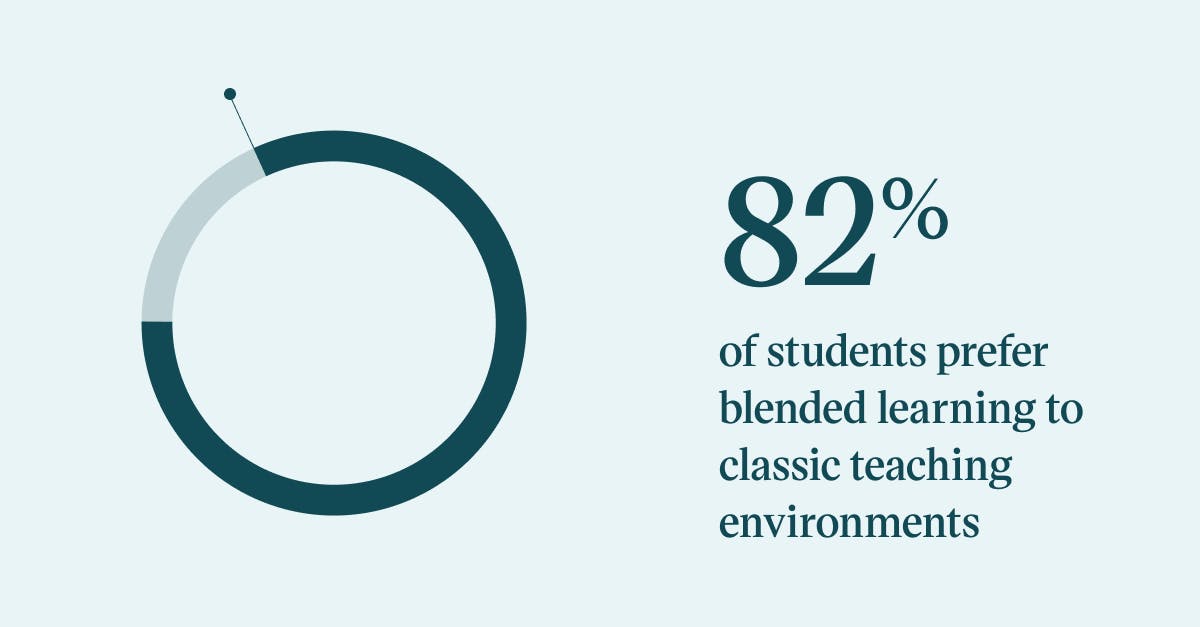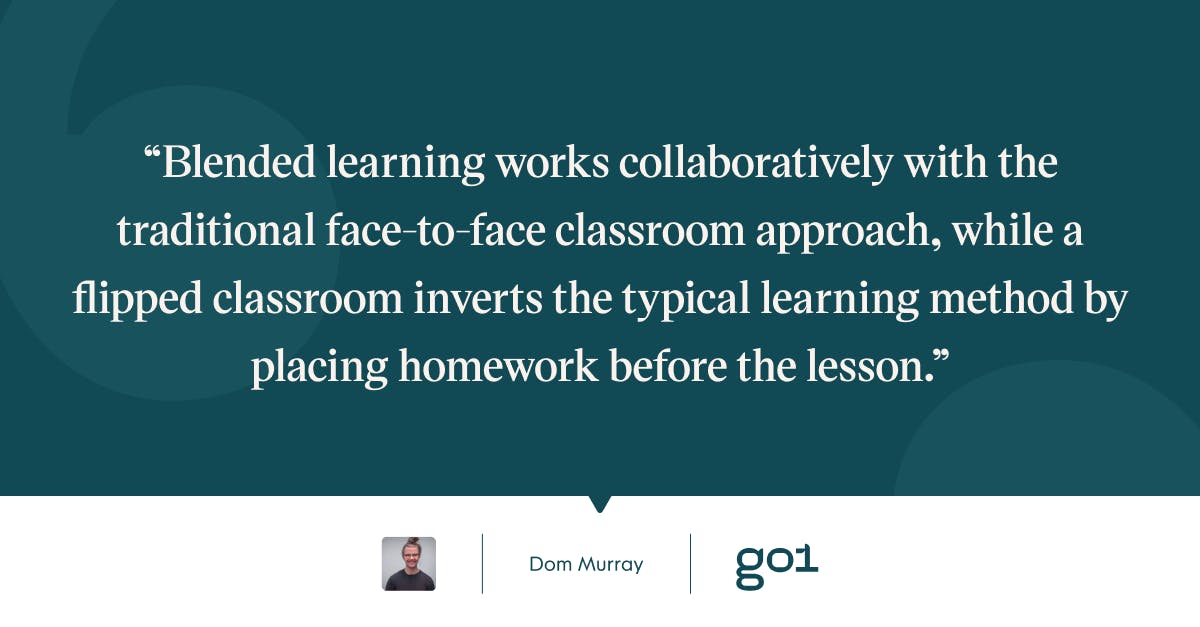
Understanding the difference between blended learning and a flipped classroom

If you spend enough time in the L&D sphere, you’ll know that it can throw up more jargon, acronyms, and specialist terms than you know how to handle. Try to explain all of these terms to an outsider, and you might be met with a blank stare and quizzically raised shoulders. ‘Blended learning’ and ‘flipped classroom’ fit nicely in this time-honoured L&D tradition. But don’t let this put you off! These methods can be among the most powerful tools in an L&D professional’s arsenal.
While the phrases are sometimes used interchangeably, blended learning and a flipped classroom are nuanced concepts with distinct meanings. With this in mind, we’ll take you through the difference between blended learning and a flipped classroom, asking what is blended learning, what is a flipped classroom, and, most importantly, which approach is suitable for you?
What is blended learning?
At its most basic, blended learning is a fairly self-explanatory term: it encompasses a blend of different learning methodologies, such as online and in-person learning. Where traditional learning is typically expected to take place face-to-face, blended learning offers a more flexible approach by combining in-person and online learning within one course.
As TeachThought puts it, “Blended learning is an approach to learning that combines face-to-face and online learning experiences. Ideally, each (both online and off) will complement the other by using its particular strengths.”
Lambda Solutions expands on this definition, adding, “Blended learning is a pedagogical or educational approach that combines traditional teaching methods, such as in a classroom setting, with eLearning technology, such as online courses, lectures, presentations, quizzes, games, and more.”
Put simply, blended learning combines in-person and online learning in a complementary way that utilises the unique benefits of each approach.
While this is far from a new term (blended learning dates back to at least the early-90s and the days of CD-ROMs as a cutting-edge learning tool), the relevance of blended learning has increased steadily in recent years. In an academic setting, 72% of teachers now say that blended learning increases learner engagement, while 82% of students prefer blended learning to classic teaching environments.

Similarly, LinkedIn’s 2021 Workplace Learning Report found that 79% of L&D teams expect to spend more time on online learning, and 73% expect to spend less time on instructor-led training. In conjunction, these statistics indicate a shift towards blended learning in many workplaces.
Blended learning in the workplace has also increased in prevalence with the move to remote working. As ATD puts it, “that’s because blended learning is site agnostic. It doesn’t matter where employees are. Access is seamless and readily available.” Another benefit of this approach is that blended learning can improve accessibility and inclusivity. This is especially important for employees who can't attend in-person events for reasons such as childcare, disability, age, or location.
Perhaps most importantly, a study into the effectiveness of blended learning found that learners who participated in a blended learning course had an average pass rate of 87.9% compared to a 71.4% pass rate for a traditional classroom. In a workplace context, these statistics generally correlate with higher engagement among employees who use blended learning.
Want to know more about blended learning? Be sure to check out our articles on why blended learning is the future of workplace learning, as well as the benefits of hybrid learning.
What is a flipped classroom?
Like blended learning, a flipped classroom is a relatively self-descriptive term. It is a role reversal of the traditional classroom dynamic. Instead of learning first and then being assigned homework, these roles are flipped. As such, learners will study the course material first and then apply this knowledge in a classroom setting (either in-person or virtually). The term ‘flipped classroom’ dates back to the mid-80s. However, the advent of modern technologies has arguably made this method more relevant and impactful than ever before.
As Lambda Solutions explains in a recent article, “A flipped classroom reverses the traditional teaching role where the lessons are first taught, and then homework is assigned. Instead, the students first study the course material, typically through online lectures, then learn how to implement what they learned in a classroom setting.”
Or, as Panopto puts it, “the flipped classroom inverts the traditional learning experience. Lectures are shared outside of class time for individual review as homework, and classroom time is reserved for class discussion and interactive projects.”
There are many benefits to a flipped classroom. For example, this learning style can help make the classroom a more active learning environment, give students more freedom to learn at their own pace, and allow teachers more time to focus on students’ individual needs rather than teaching the class as a whole.
There is also evidence to suggest that a flipped classroom model has many positive impacts. For example, 71% of teachers indicated that their students’ grades improved after implementing a flipped classroom strategy, while 96% of teachers who have flipped a lesson would recommend that method to others. Again, these results often translate to higher engagement and greater efficiency in a workplace setting.
In a professional environment, flipped learning can take many forms — from flipped training to flipped onboarding to flipped leadership development. In some workplaces, this might look like an 'emerging leadership' program that provides the necessary concepts and frameworks ahead of time, so that employees understand these before they get to 'classroom time'. Or, you may employ workshops where employees can apply their knowledge to get the most out of the time.
While this may sound like an intimidating leap into the unknown, flipped learning can be as simple as asking the presenter at your next training event to record and share foundational information beforehand, thereby flipping the script.
As Clarke Quinn, author of Revolutionize Learning & Development, explains in a recent post advocating flipping learning in the workplace, “performers are good at making decisions when they are well supported. So we should match the task to the tool, and have the tools hold the rote information and support performers through the decision process.” In other words, flipped learning is an excellent strategy to present learners with information when it is most relevant to them and in a way that increases their likelihood of engaging with and retaining that information.
Essentially, by studying the source material beforehand, students can enter the classroom (or learners can enter the workplace) confident that they have the foundational information needed to participate in activities, solidify their knowledge, and perform at their best. For some, it is simply a more efficient use of learning time.
To learn more about the benefits of a flipped classroom, check out our article on Flipped learning: a way of the future?
Which approach is right for you?
While blended learning and a flipped classroom overlap in some areas — both utilise digital technologies to facilitate learning, for example — they are distinct concepts with unique benefits and drawbacks. The right approach will vary depending on your specific learning needs and the requirements of your learners.
So, which one is right for you? Moovly provides an excellent summary of the pros and cons of blended learning and a flipped classroom. They explain, “teachers looking to shift their classroom, with an overall focus on applying theory of knowledge with the full use of technology would generally benefit more from a flipped classroom. On the contrary, a teacher wanting to provide additional support and adhere to Millennials habits would benefit more from blended learning. Simply put, if you want to extend the learning that takes place in your classroom, go for blended learning, and if you want to make more time for practical learning, flip your classroom.”

Remember, blended learning works collaboratively with the traditional face-to-face classroom approach, while a flipped classroom inverts the typical learning method by placing homework before the lesson.
Blended learning vs flipped classroom
To help make an informed decision, it is worth comparing the key benefits of blended learning and a flipped classroom. Some advantages of each approach include:
Blended learning:
- Provides significantly more flexibility and accessibility for learners
- Utilises the full potential of modern technologies to enable learning and increase engagement
- Benefits different learning styles by encouraging visual, audio, and interactive learning content
Flipped classroom:
- Allows learners more control by letting them work at their own pace
- Can increase the one-on-one time between learners and instructors
- Can make the classroom or workplace a more active and engaging learning environment
Ultimately, there is no one correct answer. Both approaches can have massive impacts in the appropriate setting. Whether you’re blending your learning or flipping your classroom, the most important thing is that you make a considered decision that accounts for your learners’ unique needs.
For more insights, be sure to subscribe to the Go1 newsletter to stay on top of all the latest L&D trends. Or, you can book a demo today to find out how Go1 can help with your team’s learning needs.




